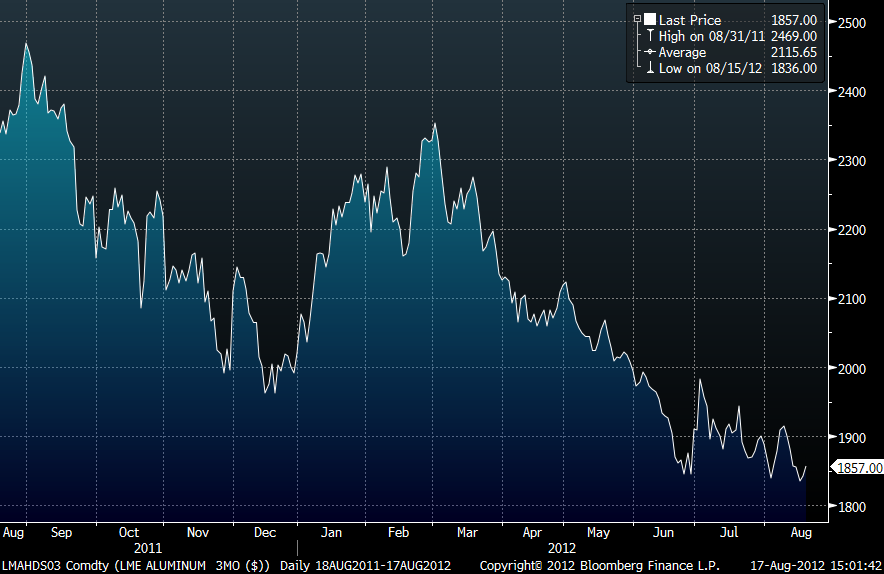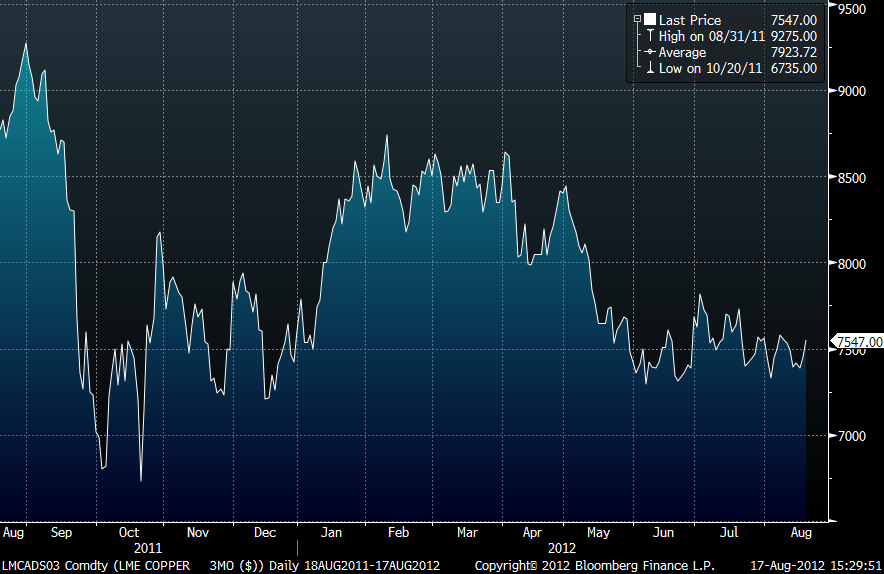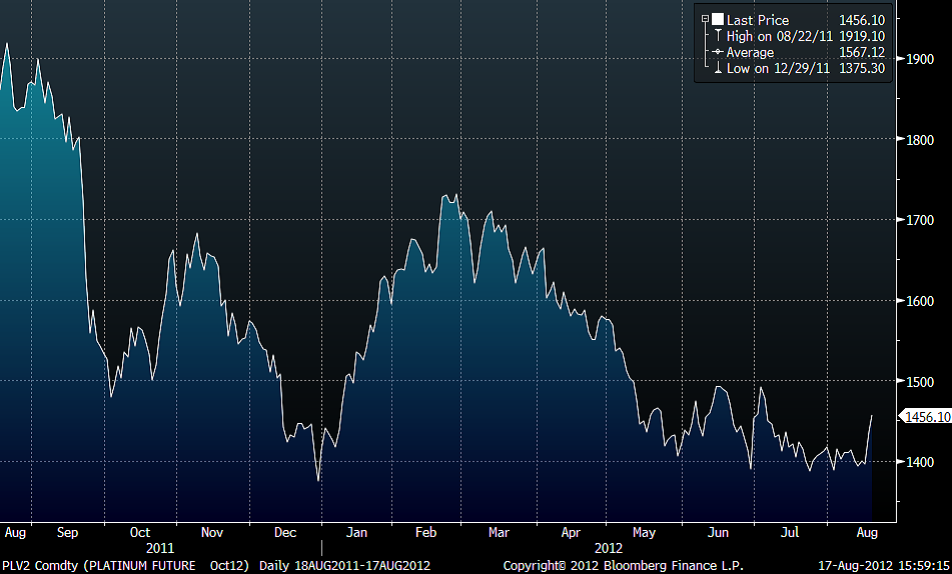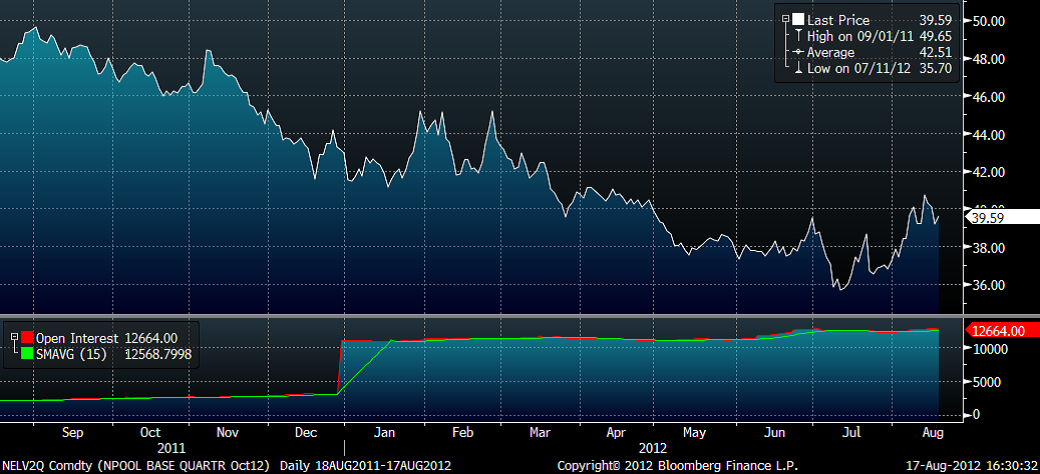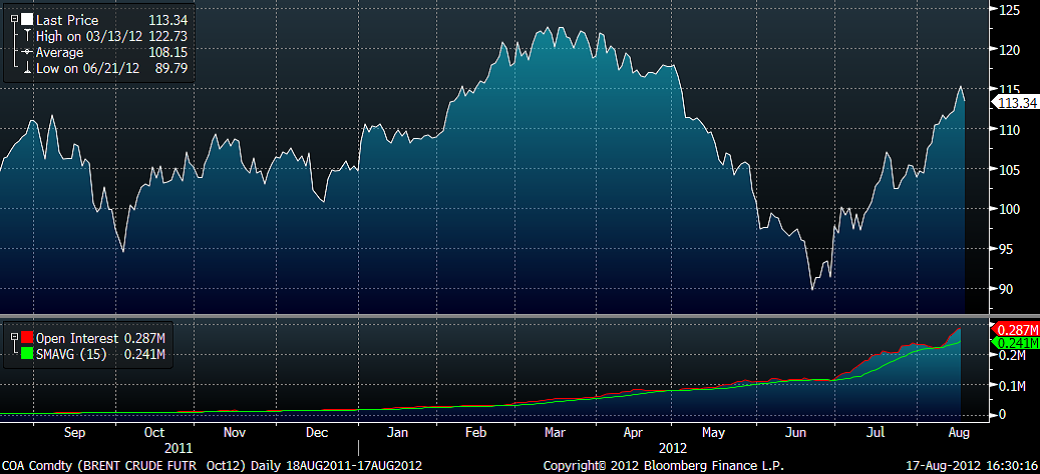Analys
SHB Råvarubrevet 17 augusti 2012
 Bättre USA och ”OK” Kina
Bättre USA och ”OK” Kina
Den amerikanska ekonomin fortsätter att visa livstecken och inte minst husmarknaden förbättras påtagligt. Risker kvarstår, framför allt i form av eventuell finanspolitisk åtstramning och spridningseffekter från Europa. Men ett antal faktorer talar för att förbättringen kommer att fortsätta under hösten. Senaste månadsstatistiken från Kina var tyvärr inte renodlad glädjeläsning men även Kina ser klart bättre ut än under våren. I förra brevet lyfte vi fram basmetaller som den råvarusektor som är mest beroende av den kinesiska konjunkturen och vi tror att köp av basmetaller på dagens låga nivåer kan bli en bra affär i väntan på kinas återhämtning under andra halvåret. Kinesisk data blir inte längre sämre och mycket talar för att botten på den kinesiska konjunkturen nåddes under sommaren.
Euroområdet fortsätter att tyngas av en icke-fungerande finansiell sektor och faktisk och stundande finanspolitisk åtstramning. Euroförsvagningen talar dock för en viss lättnad för exportsektorn framöver. Förväntningarna på europeisk makro är också rejält nedtryckta, varför det ska mycket för negativa överraskningar i närtid.
Vi bedömer att vi är mitt uppe i en omsvängningsfas för risksentimentet. Den mest pessimistiska fasen är bakom oss, men investerare är långt ifrån optimister. Först när optimismen är mer utbredd har riskrallyt nått sin kulmen. Risker mot vår syn utgörs främst av Fed och ECB om dessa misslyckas att leverera i september.
Höga förväntningar på Fed
Fedchefen Bernanke argumenterade förra sommaren för att ekonomin måste uppvisa bestående svaghet och pristrycket måste vara minskande innan fler stimulanser sjösätts. Marknaden får dock sägas prisa in stora delar av QE3. Jämförelsevis började marknaden prisa in QE2 efter Bernankes augustital 2010, och den officiella lanseringen av QE2 kom sedan i november 2010. Nästa anhalt för Fed-signaler är Jackson Hole den 31 augusti. Framförallt guldpriset har under året visat tydliga tecken på att ha förväntningar på QE inprisat. Guld lär alltså röra sig efter beskedet den 31:a. Oavsett om det blir stimulans eller inte. Stimulans kommer höja guld och utebliven stimulans kommer fortsätta sänka guldet.
Basmetaller
Aluminiumpriset ligger kvar i sin svagt nedåtgående trend och har fallit med cirka 7.8 % sedan årets början. Det positiva risksentimentet har inte alls lyckats lyfta priset och vi tror oss funnit några anledningar till detta. En viktig anledning är att den största konsumenten, Kina, har visat på vissa tillväxtproblem i ekonomin. En annan viktig faktor är att priset på insatsvarorna i aluminiumproduktionen fallit. Den kinesiska staten har beslutat sig för att sänka eltarifferna i ett antal provinser. Bedömare menar att detta sänkt marginalkostnaden med upp till 7 %. Samtidigt har priset på kinesiskt kol gått ned med drygt 20 % vilket gör livet lättare för producenter av den extremt energiintensiva metallen. Vår syn på basmetaller generellt är dock fortfarande positiv och vi tror att dagens nivåer är alltför nedpressade.
Kopparpriset har inte alls tagit så mycket stryk som aluminium. Sedan årets början är priset ned knappt 0.5 %. Det verkar som koppar tagit mer intryck av det förbättrade risksentimentet samt påverkats av de goda nyheterna kring USA:s ekonomi och då främst landets byggsektor. Lagernivåerna i Shanghai har fallit återigen och befinner sig nu på femveckorslägsta. Som bekant är vi positiva till basmetaller och vi tror att dagens nivåer är attraktiva även om exempelvis Europa skulle drabbas en kraftig ekonomisk tillbakagång. Vi har tagit del av en analys som visar att världens totala efterfrågan på koppar endast skulle minska med 1 % om Europas totala BNP skulle falla med 5 %. Marknaden förväntar sig i dagsläget en ekonomisk kontraktion i Europa på endast 0.6 %.
Ädelmetaller
Platinamarknaden har under veckan kännetecknats av volatilitet och en rad tragiska händelser. Gruvkonflikten i Sydafrika har eskalerat till blodiga sammanstötningar, där upp mot 35 människor verkar ha dödats. Våldsamheterna och produktionsproblem i andra gruvor har gjort att priset gått upp drygt 4 % under veckan. Uppgången från årets början är drygt 2 %.
Energi
I Belgien har två av sju kärnkraftverk tillfälligt stängts efter att eventuella sprickor har upptäckts i kärlet som innehåller reaktorns kärna i reaktorn Deuel 3. Man befarar att felet är tillverkningsrelaterad vilket betyder att fler kärnkraftverk finns i farozonen, totalt 21 stycken där ibland svenska ringhals 2. Oron kring europeiska kärnkraftverk har fått elpriset att stiga under senaste veckan där även spotpris och väderprognoser gett stöd till priset. Senaste dagarnas väderprognoser har dock pressat ned priset något. Igår hölls en presskonferens som meddelade att beslut om eventuella åtgärder för europeiska kärnkraftverk skjuts upp till oktober, vilket spred ett lugn i marknaden. Problematiken vid Deuel 3 kan dock sprida sig till fler kärnkraft under hösten och vi lär se en riskpremie på den kontinentala kraften tills situationen stabiliserats.
Efter en nedgång på oljepriset (brent) från 120 USD/fat under första kvartalet till 90 USD/fat den 21 juni har ett prisrally tryckt upp oljan med nästan 30% till 116 USD/fat på mindre än två månader. Oljan har tillåtits ett prisrally trots försämrad ekonomisk situation i Europa och oro över sämre ekonomiska data i Kina, USA och andra länder. Skäl som håller uppe priset på olja är oro för utbudsavbrott från Mellanöstern, lägre än väntat oljelager i USA samt hopp för fler stimulansåtgärder från centralbanker.
På utbudssidan finns fortfarande en rad oplanerade icke-OPEC avbrott och underhåll som sker i Q3. De icke-OPEC avbrott är i genomsnitt 1 miljon fat/dag YTD, ungefär dubbelt förra årets takt och betydligt mer än under 2010 som var 150 000 fat/dag. Det uppskattade amerikanska utbudet för 2012 har ökat med 1 miljoner fat/dag sedan slutet av 2011, främst beroende på ökning av skifferolja produktion, men totala icke-OPEC producenter minskar fortfarande med 500 000 fat/dag. Vi konstaterar att det finns utbudsbesvikelser i de flesta geografiska områden, förutom USA.
Samtal om Irans nukleära program har stannat upp och inga framsteg väntas innan USA:s presidentval i november. Även om oljesanktioner ger Iran ekonomiskt smärta, verkar det inte vara närmare att göra meningsfulla eftergifter. Sannolikheten för en israelisk attack kommer förmodligen växa allteftersom Iran fortsätter att avancera sitt kärnvapenprogram. Dessutom kan Syriens revolutioner lätt spilla över till grannländerna. Vår prognos för oljepriset (brent) är fortsatt på tidigare nivåer, H2 2012e och 2013e USD 110/fat medan 2014e USD 115/fat. Skifferoljans produktionstillväxt bör fortsätta, men vi tror inte att det är ett kortsiktigt hot mot oljepriset så länge outnyttjade kapaciteten är låg i OPEC. Vi får fortsätta att räkna med en risk för geopolitisk oro. Om det skulle röra sig högre än dagens nivå, skulle det sannolikt vara relaterade till mer oförutsedda störningar i försörjningen. Enligt vår mening finns det en stor risk för detta och därmed uppåtrisk för priserna.
Jordbruk
Vete
Terminspriser på vete har gått ned under veckan i både Paris och Chicago delvis påverkat av vinsthemtagning och lite regn i Australien, klart mer nederbörd behövs dock för att ta bort oron. I Europa är vädret fortfarande generellt sett bra för skörden, även i Storbritannien har det nu blivit lite torrare och rapporter om kvalitetsnivåer kommer in över förväntan trots tidigare myckna regnande. En del regn fördröjer skörden av vårvete i USA men torrt väder väntas igen nästa vecka så ingen oro verkar finnas för kvalitetsnivåer.
Det som är mest i fokus just nu är även denna vecka Ryssland, fler och fler börjar nu enas om att något politiskt beslut lär komma angående någon form av exportrestriktioner. Omkring halva skörden är nu avklarad och avkastningsnivån ligger kvar runt 30 procent lägre än förra året, längre norrut rapporteras t.o.m. om nivåer 50 procent under förra årets. USDA uppskattar den ryska veteskörden till 43 miljoner ton men flera inflytelserika ryska privata analytiker menar att en produktion runt 39 miljoner ton är mer rimlig. Med den takt Ryssland hittills exporterat vete lär de inte ha mer att sälja i slutet av oktober och redan nu uppges inhemska priser ha börjat stiga oroväckande mycket. Igår nådde prognoser om att utgående ryskt vetelager för säsongen når lägsta nivå på nio år, vilket gav press uppåt på priserna.
Nedsidan känns ganska begränsas för tillfället, men marknaden verkar behöva mer negativa nyheter för att fortsätta uppåt – vilket snabbt kan komma i form av fortsatta nedjusteringar av den ryska skörden eller fortsatt försämrat väder i Australien.
Majs
Majsen i Chicago noteras i stort sett oförändrad i pris sedan förra veckan. Den nederbörd som fallit gör nog i vissa fall nytta för sojabönorna men för majsen är det för sent. I EU är det generellt sett fortfarande torrt och varmt i majsregionerna vilket fortsätter dra ned avkastningspotentialen, i Ukraina faller dock lite välbehövd nederbörd men klart mer behövs. För tillfället är marknaden lite avvaktande och vill ha fler negativa nyheter för att driva priset ytterligare uppåt, förmodligen lär det komma inom inte alltför lång tid i form av ytterligare bekräftelse på att USDA fortfarande överskattar avkastningsnivån för den amerikanska majsen – men tänk på att vi redan ser avvikande efterfrågan som följd av de höga priserna.
Sojabönor
Sojapriserna i Chicago har gått ned i pris under veckan påverkat främst av för plantorna klart uppskattad nederbörd, regnet stabiliserar och bör i vissa regioner även kunna förbättra avkastningsnivån något. Vissa prognoser pekar även på lite bättre väder framöver men det är som vanligt mer osäkert. Både inhemsk amerikansk efterfrågan och export är dock fortfarande stark så nedsidan bör vara klart begränsad och mer rimligt är kanske att priserna stiger något för att dämpa efterfrågan tills den sydamerikanska skörden närmar sig (ett halvår dit).
Softs
Kaffe
Det varma och torra vädret i Brasilien fortsätter vilket är gynnsamt för skörden som fördröjts till följd av det kraftiga regnet i maj och juni. Meteorloger förutspår att det torra varma vädret håller i sig genom hela augusti, vilket gynnar skörden som kan komma att avslutas redan under första halvan av september. Delar av den brasilianska skörden har gått förlorad p.g.a. regnet. Utbudet på marknaden är lågt då säljarna verkar invänta en något högre prisnivå för att kompensera för de delar av skörden som gått förlorad. Priset på kaffe fick tidigare i veckan en ytterligare skjuts neråt till följd av amerikanska siffror som visar på ökad lagerhållning av råkaffe. Hittills gott om bär i Centralamerika men spekulationer finns om att den kommande skörden kan bli något mindre än tidigare år till följd av oregelbunden nederbörd under blomning. Marknaden följer även utvecklingen av El Nino och dess eventuella påverkan på den internationella kaffeproduktionen framöver.
Socker
Det brasilianska vädret i maj och juni påverkade även socker skörden negativt. Exporten av råvaran har kommit igång och utbudet av det brasilianska sockret ökar. Marknaden följer utvecklingen av monsunperioden i Indien som hittills iår genererat mindre nederbörd än estimerat vilket kan komma att ha betydande inverkan på landets export. Än så länge exporterar Indien socker men ifall nederbörden fortsätter vara otillräcklig kommer landets exportsiffra sjunka avsevärt.
Kakao
Det torra vädret i västafrika fortsätter och är inte gynnsamt för den kommande skörden. Nederböden i västra Ghana mättes från 1-10 augusti till 4,5 mm att jämföra med 35,4 mm samma period året innan. Västafrika står för ca 2/3 av cacaot på den globala marknaden och det säger sig självt att torka får konsekvenser för det totala utbudet. Marknaden följer även här väderfenomenet El Ninos utveckling och skulle den detta år vara av det kraftigare slaget, vilket det finns indikationer på, finns det risk för att den totala efterfrågan växer snabbare än utbudet säsongen 2012-13. Även sydostasien skulle må bra av regn då klimatet för tillfället är för torrt för att nå bästa möjliga skörd.
Apelsinjuice
Utbudet av apelsinjuice fortsätter att vara stort och den låga efterfrågan håller priset nere. Om vi tittar på priskurvan de senaste veckorna kan vi se att den går så gott som hand i hand med väderleksrapporterna för Florida och den orkansäsong de är mitt uppe i. En ökad varning för att den tropiska storm som igår befann sig över havet skulle kunna öka i styrka ledde till ökad handel och ett något högre pris. Stormen har tagit en annan riktning och utgör inte längre något större hot för att nå land och därmed heller ingen risk för att skada skördarna. Detta tillsammans med uttalanden om att nästa års skörd skulle kunna komma att överstiga årets rekordskördar fick priset att sjunka.
[box]SHB Råvarubrevet är producerat av Handelsbanken och publiceras i samarbete och med tillstånd på Råvarumarknaden.se[/box]
Ansvarsbegränsning
Detta material är producerat av Svenska Handelsbanken AB (publ) i fortsättningen kallad Handelsbanken. De som arbetar med innehållet är inte analytiker och materialet är inte oberoende investeringsanalys. Innehållet är uteslutande avsett för kunder i Sverige. Syftet är att ge en allmän information till Handelsbankens kunder och utgör inte ett personligt investeringsråd eller en personlig rekommendation. Informationen ska inte ensamt utgöra underlag för investeringsbeslut. Kunder bör inhämta råd från sina rådgivare och basera sina investeringsbeslut utifrån egen erfarenhet.
Informationen i materialet kan ändras och också avvika från de åsikter som uttrycks i oberoende investeringsanalyser från Handelsbanken. Informationen grundar sig på allmänt tillgänglig information och är hämtad från källor som bedöms som tillförlitliga, men riktigheten kan inte garanteras och informationen kan vara ofullständig eller nedkortad. Ingen del av förslaget får reproduceras eller distribueras till någon annan person utan att Handelsbanken dessförinnan lämnat sitt skriftliga medgivande. Handelsbanken ansvarar inte för att materialet används på ett sätt som strider mot förbudet mot vidarebefordran eller offentliggörs i strid med bankens regler.
Analys
Tightening fundamentals – bullish inventories from DOE

The latest weekly report from the US DOE showed a substantial drawdown across key petroleum categories, adding more upside potential to the fundamental picture.

Commercial crude inventories (excl. SPR) fell by 5.8 million barrels, bringing total inventories down to 415.1 million barrels. Now sitting 11% below the five-year seasonal norm and placed in the lowest 2015-2022 range (see picture below).
Product inventories also tightened further last week. Gasoline inventories declined by 2.1 million barrels, with reductions seen in both finished gasoline and blending components. Current gasoline levels are about 3% below the five-year average for this time of year.
Among products, the most notable move came in diesel, where inventories dropped by almost 4.1 million barrels, deepening the deficit to around 20% below seasonal norms – continuing to underscore the persistent supply tightness in diesel markets.
The only area of inventory growth was in propane/propylene, which posted a significant 5.1-million-barrel build and now stands 9% above the five-year average.
Total commercial petroleum inventories (crude plus refined products) declined by 4.2 million barrels on the week, reinforcing the overall tightening of US crude and products.


Analys
Bombs to ”ceasefire” in hours – Brent below $70

A classic case of “buy the rumor, sell the news” played out in oil markets, as Brent crude has dropped sharply – down nearly USD 10 per barrel since yesterday evening – following Iran’s retaliatory strike on a U.S. air base in Qatar. The immediate reaction was: “That was it?” The strike followed a carefully calibrated, non-escalatory playbook, avoiding direct threats to energy infrastructure or disruption of shipping through the Strait of Hormuz – thus calming worst-case fears.

After Monday morning’s sharp spike to USD 81.4 per barrel, triggered by the U.S. bombing of Iranian nuclear facilities, oil prices drifted sideways in anticipation of a potential Iranian response. That response came with advance warning and caused limited physical damage. Early this morning, both the U.S. President and Iranian state media announced a ceasefire, effectively placing a lid on the immediate conflict risk – at least for now.
As a result, Brent crude has now fallen by a total of USD 12 from Monday’s peak, currently trading around USD 69 per barrel.
Looking beyond geopolitics, the market will now shift its focus to the upcoming OPEC+ meeting in early July. Saudi Arabia’s decision to increase output earlier this year – despite falling prices – has drawn renewed attention considering recent developments. Some suggest this was a response to U.S. pressure to offset potential Iranian supply losses.
However, consensus is that the move was driven more by internal OPEC+ dynamics. After years of curbing production to support prices, Riyadh had grown frustrated with quota-busting by several members (notably Kazakhstan). With Saudi Arabia cutting up to 2 million barrels per day – roughly 2% of global supply – returns were diminishing, and the risk of losing market share was rising. The production increase is widely seen as an effort to reassert leadership and restore discipline within the group.
That said, the FT recently stated that, the Saudis remain wary of past missteps. In 2018, Riyadh ramped up output at Trump’s request ahead of Iran sanctions, only to see prices collapse when the U.S. granted broad waivers – triggering oversupply. Officials have reportedly made it clear they don’t intend to repeat that mistake.
The recent visit by President Trump to Saudi Arabia, which included agreements on AI, defense, and nuclear cooperation, suggests a broader strategic alignment. This has fueled speculation about a quiet “pump-for-politics” deal behind recent production moves.
Looking ahead, oil prices have now retraced the entire rally sparked by the June 13 Israel–Iran escalation. This retreat provides more political and policy space for both the U.S. and Saudi Arabia. Specifically, it makes it easier for Riyadh to scale back its three recent production hikes of 411,000 barrels each, potentially returning to more moderate increases of 137,000 barrels for August and September.
In short: with no major loss of Iranian supply to the market, OPEC+ – led by Saudi Arabia – no longer needs to compensate for a disruption that hasn’t materialized, especially not to please the U.S. at the cost of its own market strategy. As the Saudis themselves have signaled, they are unlikely to repeat previous mistakes.
Conclusion: With Brent now in the high USD 60s, buying oil looks fundamentally justified. The geopolitical premium has deflated, but tensions between Israel and Iran remain unresolved – and the risk of missteps and renewed escalation still lingers. In fact, even this morning, reports have emerged of renewed missile fire despite the declared “truce.” The path forward may be calmer – but it is far from stable.
Analys
A muted price reaction. Market looks relaxed, but it is still on edge waiting for what Iran will do

Brent crossed the 80-line this morning but quickly fell back assigning limited probability for Iran choosing to close the Strait of Hormuz. Brent traded in a range of USD 70.56 – 79.04/b last week as the market fluctuated between ”Iran wants a deal” and ”US is about to attack Iran”. At the end of the week though, Donald Trump managed to convince markets (and probably also Iran) that he would make a decision within two weeks. I.e. no imminent attack. Previously when when he has talked about ”making a decision within two weeks” he has often ended up doing nothing in the end. The oil market relaxed as a result and the week ended at USD 77.01/b which is just USD 6/b above the year to date average of USD 71/b.

Brent jumped to USD 81.4/b this morning, the highest since mid-January, but then quickly fell back to a current price of USD 78.2/b which is only up 1.5% versus the close on Friday. As such the market is pricing a fairly low probability that Iran will actually close the Strait of Hormuz. Probably because it will hurt Iranian oil exports as well as the global oil market.
It was however all smoke and mirrors. Deception. The US attacked Iran on Saturday. The attack involved 125 warplanes, submarines and surface warships and 14 bunker buster bombs were dropped on Iranian nuclear sites including Fordow, Natanz and Isfahan. In response the Iranian Parliament voted in support of closing the Strait of Hormuz where some 17 mb of crude and products is transported to the global market every day plus significant volumes of LNG. This is however merely an advise to the Supreme leader Ayatollah Ali Khamenei and the Supreme National Security Council which sits with the final and actual decision.
No supply of oil is lost yet. It is about the risk of Iran closing the Strait of Hormuz or not. So far not a single drop of oil supply has been lost to the global market. The price at the moment is all about the assessed risk of loss of supply. Will Iran choose to choke of the Strait of Hormuz or not? That is the big question. It would be painful for US consumers, for Donald Trump’s voter base, for the global economy but also for Iran and its population which relies on oil exports and income from selling oil out of that Strait as well. As such it is not a no-brainer choice for Iran to close the Strait for oil exports. And looking at the il price this morning it is clear that the oil market doesn’t assign a very high probability of it happening. It is however probably well within the capability of Iran to close the Strait off with rockets, mines, air-drones and possibly sea-drones. Just look at how Ukraine has been able to control and damage the Russian Black Sea fleet.
What to do about the highly enriched uranium which has gone missing? While the US and Israel can celebrate their destruction of Iranian nuclear facilities they are also scratching their heads over what to do with the lost Iranian nuclear material. Iran had 408 kg of highly enriched uranium (IAEA). Almost weapons grade. Enough for some 10 nuclear warheads. It seems to have been transported out of Fordow before the attack this weekend.
The market is still on edge. USD 80-something/b seems sensible while we wait. The oil market reaction to this weekend’s events is very muted so far. The market is still on edge awaiting what Iran will do. Because Iran will do something. But what and when? An oil price of 80-something seems like a sensible level until something do happen.
-

 Nyheter3 veckor sedan
Nyheter3 veckor sedanStor uppsida i Lappland Guldprospekterings aktie enligt analys
-

 Nyheter4 veckor sedan
Nyheter4 veckor sedanBrookfield ska bygga ett AI-datacenter på hela 750 MW i Strängnäs
-

 Nyheter3 veckor sedan
Nyheter3 veckor sedanSilverpriset släpar efter guldets utveckling, har mer uppsida
-

 Nyheter4 veckor sedan
Nyheter4 veckor sedanTradingfirman XTX Markets bygger datacenter i finska Kajana för 1 miljard euro
-

 Nyheter2 veckor sedan
Nyheter2 veckor sedanUppgången i oljepriset planade ut under helgen
-

 Nyheter2 veckor sedan
Nyheter2 veckor sedanLåga elpriser i sommar – men mellersta Sverige får en ökning
-

 Analys2 veckor sedan
Analys2 veckor sedanVery relaxed at USD 75/b. Risk barometer will likely fluctuate to higher levels with Brent into the 80ies or higher coming 2-3 weeks
-

 Nyheter1 vecka sedan
Nyheter1 vecka sedanMahvie Minerals växlar spår – satsar fullt ut på guld


